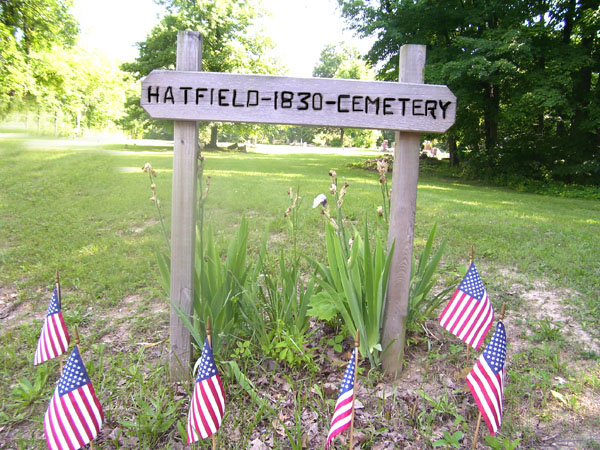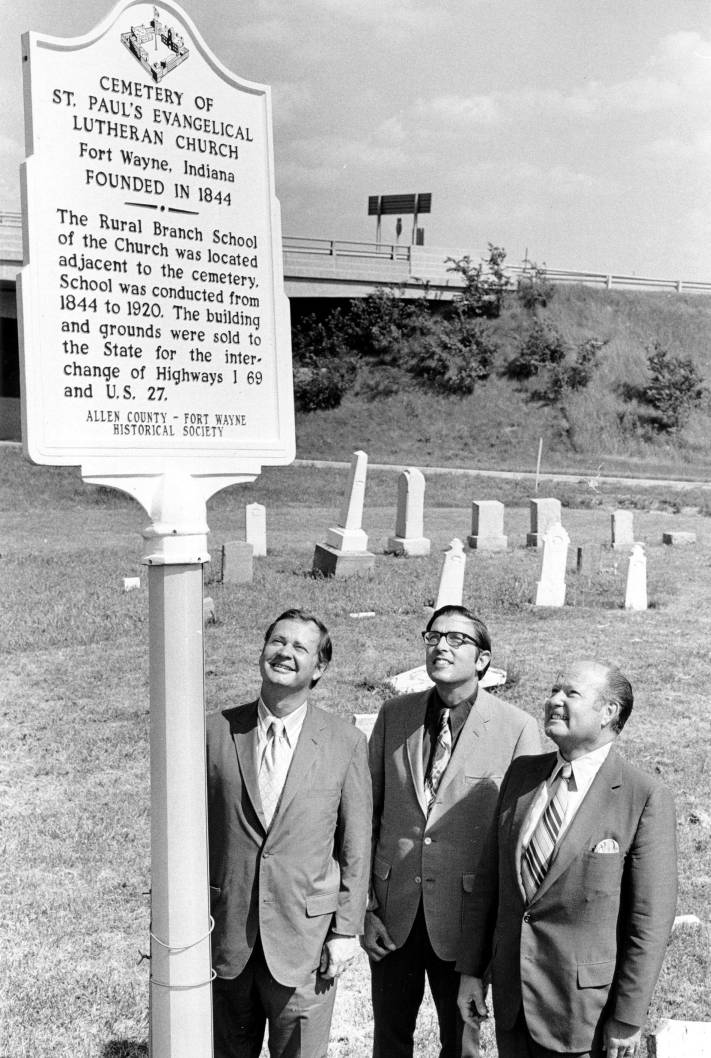David Archer Cemetery in Johnny Appleseed Park
Some of the earliest cemetery photos of the Archer Cemetery are from the burial location of John Chapman aka
Johnny Appleseed.The Tumbledown Gate to Archer Burying Ground
Article from Jul 17, 1915 The Fort Wayne Sentinel (Fort Wayne, Indiana) Archer cemetery, Johnny appleseedThe Tumbledown Gate to Archer Burying Ground The Fort Wayne Sentinel, Fort Wayne, Indiana, Saturday, July 17, 1915, Page 7
Archer Burying Ground, Near Ft. Wayne, Where Johnny Appleseed Sleeps
Article from Jul 17, 1915 The Fort Wayne Sentinel (Fort Wayne, Indiana) Johnny appleseed, Archer cemeteryArcher Burying Ground, Near Ft. Wayne, Where Johnny Appleseed Sleeps The Fort Wayne Sentinel, Fort Wayne, Indiana, Saturday, July 17, 1915, Page 7
On the hill near the east side of Parnell Avenue, southeast Harry Baals Drive and just south of the Allen County War Memorial Coliseum parking lots. A 1972 application for the Johnny Appleseed Memorial Park to the National Register of Historic Places at the National Park Service on page 2 under Item 7, Description, states the Old David Archer cemetery consisting of 2 acres of land, and containing the grave of John Chapman, known as Johnny Appleseed
. If the cemetery contained 2 acres of land how many other pioneers were buried here and what happened to their tombstones and any records of burials? The local Mary Penrose Wayne Chapter NSDAR photographed the cemetery in April 2009 and found only 3 tombstones, but lists 22 names from their 1932 DAR readings on their Archer Cemetery web page.

Go to Mary Penrose DAR photos
This early settler cemetery includes the John Johnny Appleseed
Chapman burial site. IN DNR Latitude 41.1117 Longitude 85.1233. See our Johnny Appleseed and Johnny Appleseed Newpaper page for more information especially a July 15, 1923 description of the status of the Johnny Appleseed grave site describing the site as: we found one of the most neglected and lonely burial places in all Indiana. A tangle undergrowth of brier, shrub and tree, with here and there a headstone, half buried, half revealed in the sandy soil, indicated the nature of the place. An iron fence surrounding the grave of Johnny Apppleseed gave information that it had been placed there by the Horticultural society of Indiana. This, and nothing more.
.
Go to: DAR tombstone photos, Find-A-Grave, Google map, 31 acre Johnny Appleseed Park south and east of the Allen County War Memorial Coliseum, and Hiker Central reviews the camp ground.
More ‘buried concerns’: Losing graves has happened fairly frequently in Fort Wayne’s history by Joshua Schipper posted December 15, 2021 in Wikimedia Commons.org. Discusses Chief Little Turtle burial location, Johnny Appleseed and Archer Cemetery, the Broadway Cemetery now McCulloch Park, and Chief Richardville burial location.
A May 3, 1914 newspaper article Two Men in Allen County Were Present at Appleseed Funeral. Clipped from The Fort Wayne Journal-Gazette 03 May 1914, Sunday, page 6, by StanFollisFW on 20 Feb 2022 says the cemetery In addition to Appleseed, some twenty or twenty-five persons have been buried in the David Archer cemetery. It contains about a half acre of ground and consequently not large enough to bury a great number.
Another article on May 10, 1914 states it originally contained the graves of around 150 people! "Too Bad Johnny Appleseed Died So Early in Life;" His Life; Work Clipped from The Fort Wayne Journal-Gazette 10 May 1914, Sunday, page 48, by RonaldChard1960 on 24 March 2017 titled: Another Johnny Appleseed article from 1914. Hiram Porter living on a farm in St. Joe township recalled Johnny Appleseed. In one paragraph he says: I can show you the cemetery and the spot where Appleseed is buried. If I am not mistaken 150 [6?] people are buried there. My father and my two wives rest there, my three children and a brother and sister. That was known as the Old David Archer cemetery and for many years it was quite a curiosity. Now it seems to me more of a curiosity than ever from the way people are talking about it.
So one has to wonder if either article is correct?
1914 - The David Archer Burial Ground - John Chapman "Johnnie Appleseed"
Article from Jun 20, 1914 The Fort Wayne Sentinel (Fort Wayne, Indiana) 1914, David archer burial grounds, John chapman, Johnnie appleseed1914 - The David Archer Burial Ground - John Chapman "Johnnie Appleseed" The Fort Wayne Sentinel, Fort Wayne, Indiana, Saturday, June 20, 1914, Page 11
The David Archer Burying Ground - John Chapman "Johnnie Appleseed" - after an old woodcut
JOHNNIE APPLESEED. HIS HANDWRITING AND HIS BURIAL PLACE.
[ OCR transcription of nearly illegible newsprint with some corrections ]
John Chapman, known as Johnnie Appleseed." died at the home of William Worth, near Fort Wayne in 1847. The historical account of death and his rial(?) by the Worths and Vietr(?) neighbors, the the Goings(?), Porters. Notestines, Beckets, Parkers, Witesides(?), Perchons, Hatfields, Parrants, Randells and the Archers, in the Archer burial ground, is substantially ? wrote John Archer in 1900. "The common headboard used in those days long since have decayed and become entirely obliterated, and at this time I do not think that any person could, with any degree of certainty, come within fifty feet of locating the grave." The burying ground is located a few rods near at stop on the Robison park ele tru lite Johnnie Appleseed 18 the hero of 1r Dwight Hillia* rap. tale. "The Wurst of John and the story of his life, which was spent in planting apple trees throughout the wilderness of the middle west. is familiar to the school children of America. The portrait and the facsimile of an order for apple trees, written by John Chapman. are altor engravings which accompanied an articl E. o. Randall in Vol. IX of the Ohio Archacological and Historica! society publications. A monument to the ? of John Chapman, the gift of M. E. Bushnell, was dedicated in November, 191 at Mansfield, Ohio.
[ See our Johnny Appleseed Newspaper page ]
December 15, 2021 post by Joshua Schipperon Facebook:
This is one of the most heavily researched pieces I've written. It was fun to be able to travel to these historic sites and conduct some scavenger hunt research over the last two months!
#fortwayne #news #local #cemetery #historymatters #history
Allen County Genealogical Society of Indiana
More ‘buried concerns’: Losing graves has happened fairly frequently in Fort Wayne’s history Joshua Schipper, December 15, 2021 on Input Fort Wayne.
Also posted on Facebook by Input Fort Wayne on December 23, 2021.
A December 15, 2021 comment to the post said missing tombstones from the Archer Cemetery near the Allen County Memorial Coliseum may be somewhere in the coliseum. Anyone know anything. This is also known as the Johnny Appleseed Graveyard.


 Find-A-Grave photo
Find-A-Grave photo



